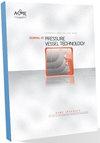利用HDPE/LDPE直列截面管去除空化
IF 1
4区 工程技术
Q4 ENGINEERING, MECHANICAL
Journal of Pressure Vessel Technology-Transactions of the Asme
Pub Date : 2022-08-03
DOI:10.1115/1.4055155
引用次数: 1
摘要
本文从幅度衰减和压力波振荡周期扩展两个方面研究了在线技术升级钢管液压系统的能力。该技术包括用另一种塑料材料类型(包括高密度或低密度聚乙烯(HDPE或LDPE))取代诱导瞬态压力区域的一小段。采用特征方法对扩展的一维水锤方程进行离散化,嵌入Ramos等人的公式。数值解与文献中引用的观测数据和备选数值解的比较证明了所开发的求解器的准确性。测试用例处理了一个涉及空化开始的瞬态流。结果表明,与LDPE塑料短截面布局和HDPE或LDPE材料为主管道系统相比,HDPE塑料短截面布局在震级衰减和压力波振荡周期扩展之间提供了最好的折衷。本文章由计算机程序翻译,如有差异,请以英文原文为准。
Removal of Cavitation Using HDPE/LDPE Inline Section-Pipe
This study dealt with the capacity of the inline technique to upgrade steel-pipe -based hydraulic systems with respect to magnitude attenuation and pressure-wave oscillation period expansion. This technique consisted in replacing a short-section of the induced transient pressure region with another of plastic material type, including High- or Low-Density PolyEthylene (HDPE or LDPE). The Method Of Characteristics was implemented to discretize the Extended One-Dimensional Water-Hammer Equations, embedding the Ramos et al. formulation. The comparison of the numerical solution with the observed data, quoted in the literature, and alternative numerical solution demonstrated the accuracy of the developed solver. The test case addressed a transient flow involving the cavitation onset. Results showed that the HDPE plastic-short-section -based layout of the inline technique provided the best tradeoff between magnitude attenuation and pressure-wave oscillation period expansion, in comparison with the LDPE plastic-short-section -based layout and the HDPE or LDPE material -based main-pipe systems.
求助全文
通过发布文献求助,成功后即可免费获取论文全文。
去求助
来源期刊
CiteScore
2.10
自引率
10.00%
发文量
77
审稿时长
4.2 months
期刊介绍:
The Journal of Pressure Vessel Technology is the premier publication for the highest-quality research and interpretive reports on the design, analysis, materials, fabrication, construction, inspection, operation, and failure prevention of pressure vessels, piping, pipelines, power and heating boilers, heat exchangers, reaction vessels, pumps, valves, and other pressure and temperature-bearing components, as well as the nondestructive evaluation of critical components in mechanical engineering applications. Not only does the Journal cover all topics dealing with the design and analysis of pressure vessels, piping, and components, but it also contains discussions of their related codes and standards.
Applicable pressure technology areas of interest include: Dynamic and seismic analysis; Equipment qualification; Fabrication; Welding processes and integrity; Operation of vessels and piping; Fatigue and fracture prediction; Finite and boundary element methods; Fluid-structure interaction; High pressure engineering; Elevated temperature analysis and design; Inelastic analysis; Life extension; Lifeline earthquake engineering; PVP materials and their property databases; NDE; safety and reliability; Verification and qualification of software.

 求助内容:
求助内容: 应助结果提醒方式:
应助结果提醒方式:


